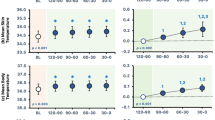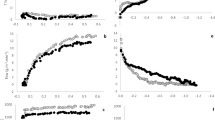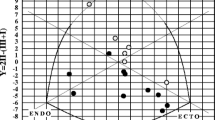Abstract
This study aimed to test the primary hypotheses that human thermoregulatory behavior is: (1) initiated before changes in rectal or esophageal temperatures; and (2) accompanied by indiscernible differences in sweating or shivering. This was achieved by placing nine, healthy, males in a situation where they were free to move between a cold (~8 °C) and a hot (~46 °C) environment. Upon behaving [i.e., move from cold to hot (C→H) or from hot to cold (H→C)], skin, rectal, and esophageal temperatures, indices of cutaneous vasomotor tone, metabolism and evaporation, and local and whole-body thermal discomfort were recorded. Rectal temperatures were similar at H→C (37.1 ± 0.2 °C) and C→H (37.1 ± 0.2 °C); yet esophageal temperatures were higher at C→H (36.9 ± 0.2 vs. 36.8 ± 0.2 °C). Skin temperature (C→H, 28.4 ± 0.9 vs. H→C, 35.0 ± 0.6 °C) and vasomotor tone were drastically different upon the decision to behave. Metabolic heat production was lower at H→C (79 ± 10 W/m2) than at C→H (101 ± 20 W/m2), yet there were no statistical differences in evaporative heat loss (C→H, 23 ± 33 W/m2 vs. H→C, 52 ± 36 W/m2). Whole-body thermal discomfort was similar at C→H and H→C, yet there were inter-segmental differences. These findings indicate that skin temperature, not core temperature, plays a signaling role in the decision to behaviorally thermoregulate. However, this behavior does not occur in the complete absence of autonomic thermoregulatory responses.




Similar content being viewed by others
References
Arens E, Zhang H, Huizenga C (2006a) Partial- and whole-body thermal sensation and comfort—part I: uniform environmental conditions. J Therm Biol 31:53–59
Arens E, Zhang H, Huizenga C (2006b) Partial- and whole-body thermal sensation and comfort—part II: non-uniform environmental conditions. J Therm Biol 31:60–66
Attia M, Engel P (1981) Thermal alliesthesial response in man is independent of skin location stimulated. Physiol Behav 27:439–444
Barber BJ, Crawford EC (1979) Dual threshold control of peripheral temperature in the lizard dipsosaurus-dorsalis. Physiol Zool 52:250–263
Benzinger T (1969) Heat regulation—homeostasis of central temperature in man. Physiol Rev 49:671–759
Benzinger TH, Pratt AW, Kitzinger C (1961) The thermostatic control of human metabolic heat production. Proc Natl Acad Sci USA 47:730–739
Bratincsak A, Palkovits M (2005) Evidence that peripheral rather than intracranial thermal signals induce thermoregulation. Neuroscience 135:525–532
Cabanac M, Massonnet B (1977) Thermoregulatory responses as a function of core temperature in humans. J Physiol 265:587–596
Cabanac M, Bleichert R, Massonne B (1972) Preferred skin temperature as a function of internal and mean skin temperature. J Appl Physiol 33:699–703
Carlisle HJ (1968) Peripheral thermal stimulation and thermoregulatory behavior. J Comp Physiol Psychol 66:507–510
Cheng C, Matsukawa T, Sessler DI, Ozaki M, Kurz A, Merrifield B, Lin H, Olofsson P (1995) Increasing mean skin temperature linearly reduces the core-temperature thresholds for vasoconstriction and shivering in humans. Anesthesiology 82:1160–1168
Cranston WI, Gerbrandy J, Snell ES (1954) Oral, rectal and oesophageal temperatures and some factors affecting them in man. J Physiol 126:347–358
Crowe JP, Moore RE (1974) Physiological and behavoural responses of aged men to passive heating. J Physiol 236:43–45 (Proceedings)
Dubois D, Dubois EF (1916) A formula to estimate approximate surface area if height and weight be known. Arch Intern Med 17:863–871
Epstein AN, Milestone R (1968) Showering as a coolant for rats exposed to heat. Science 160:895–896
Flouris A, Cheung S (2008) Human conscious response to thermal input is adjusted to changes in mean body temperature. Br J Sports Med 43:199–203
Flouris AD, Cheung SS (2010) Thermometry and calorimetry assessment of sweat response during exercise in the heat. Eur J Appl Physiol 108:905–911
Flouris AD, Cheung SS (2011) Thermal basis of finger blood flow adaptations during abrupt perturbations in thermal homeostasis. Microcirculation 18:56–62
Gagge AP, Stolwijk JA, Hardy JD (1967) Comfort and thermal sensations and associated physiological responses at various ambient temperatures. Environ Res 1:1–20
Gordon CJ (1985) Relationship between autonomic and behavioral thermoregulation in the mouse. Physiol Behav 34:687–690
Graichen H, Rascati R, Gonzalez RR (1982) Automatic dew-point temperature sensor. J Appl Physiol 52:1658–1660
Hardy JD (1971) Thermal comfort and health. Ashrae J 13:43–51
Hardy JD, Dubois EF (1938) The technic of measuring radiation and convection. J Nutr 15:461–475
Hardy JD, Gagge AP, Stolwijk JA (eds) (1970) Physiological and behavioral temperature regulation. Charles C Thomas, Springfield
House JR, Tipton MJ (2002) Using skin temperature gradients or skin heat flux measurements to determin thresholds of vasoconstriction and vasodilatation. Eur J Appl Physiol 88:141–145
ISO8996 (1989) Ergonomics of thermal environments—determination of metabolic heat production. Organization ISO, Geneva
Jackson AS, Pollock ML (1978) Generalized equations for predicting body density of men. Br J Nutr 40:497–504
Kenney WL (1998) Heat flux and storage in hot environments. Int J Sports Med 19:S92–S95
Kolka MA, Quigley MD, Blanchard LA, Toyota DA, Stephenson LA (1993) Validation of a temperature telemetry system during moderate and strenuous exercise. J Therm Biol 18:203–210
Mekjavic IB, Rempel ME (1990) Determination of esophageal probe insertion length based on standing and sitting height. J Appl Physiol 69:376–379
Mercer J (2001) Glossary of terms for thermal physiology, 3rd edn. Revised by the IUPS thermal commission. Jap J Physiol 51:245–280
Mitchell JW, Nadel ER, Stolwijk JA (1972) Respiratory weight losses during exercise. J Appl Physiol 32:474–476
Mower GD (1976) Perceived intensity of peripheral thermal stimuli is independent of internal body temperature. J Comp Physiol Psychol 90:1152–1155
Nakamura M, Yoda T, Crawshaw LI, Yasuhara S, Saito Y, Kasuga M, Nagashima K, Kanosue K (2008) Regional differences in temperature sensation and thermal comfort in humans. J Appl Physiol 105:1897–1906
Nakamura M, Yoda T, Crawshaw LI, Kasuga M, Uchida Y, Tokizawa K, Nagashima K, Kanosue K (2012) Relative importance of different surface regions for thermal comfort in humans. Eur J Appl Physiol. doi: 10.1007/s00421-012-2406-9
Parsons KC (2003) Human thermal environments. Taylor and Francis, London
Romanovsky AA (2007) Thermoregulation: some concepts have changed. Functional architecture of the thermoregulatory system. Am J Physiol Regul Integr Comp Physiol 292:R37–R46
Rowell LB, Brengelmann GL, Murray JA (1969) Cardiovascular responses to sustained high skin temperature in resting man. J Appl Physiol 27:673–680
Rubinstein EH, Sessler DI (1990) Skin-surface temperature-gradients correlate with fingertip blood-flow in humans. Anesthesiology 73:541–545
Schlader ZJ, Prange HD, Mickleborough TD, Stager JM (2009) Characteristics of the control of human thermoregulatory behavior. Physiol Behav 98:557–562
Schlader ZJ, Stannard SR, Mundel T (2010) Human thermoregulatory behavior during rest and exercise—a prospective review. Physiol Behav 99:269–275
Schlader ZJ, Simmons SE, Stannard SR, Mundel T (2011a) The independent roles of temperature and thermal perception in the control of human thermoregulatory behavior. Physiol Behav 103:217–224
Schlader ZJ, Simmons SE, Stannard SR, Mundel T (2011b) Skin temperature as a thermal controller of exercise intensity. Eur J Appl Physiol 11:1631–1639
Schlader ZJ, Stannard SR, Mundel T (2011c) Evidence for thermoregulatory behavior during self-paced exercise in the heat. J Therm Biol 36:390–396
Schmidt I (1978) Interactions of behavioral and autonomic thermoregulation in heat stressed pigeons. Pflug Arch Eur J Phys 374:47–55
Siri WE (1961) Body composition from fluid spaces and density: analysis of methods. In: Brozek J, Henschel A (eds) Techniques for measuring body composition. National Academy of Sciences, National Research Council, Washington DC, pp 223–243
Stitt JT, Adair ER, Nadel ER, Stolwijk JA (1971) The relation between behavior and physiology in the thermoregulatory response of the squirrel moneky. J Physiol (Paris) 63:424–427
Taylor NAS, Allsopp NK, Parkes DG (1995) Preferred room-temperature of young vs aged males—the influence of thermal sensation, thermal comfort, and affect. J Gerontol A Biol 50:M216–M221
Tikuisis P (2003) Heat balance precedes stabilization of body temperatures during cold water immersion. J Appl Physiol 95:89–96
Werner J, Mekjavic IB, Taylor NAS (2008) Concepts in physiological regulation: a thermoregulatory perspective. In: Taylor NAS, Groeller H (eds) Physiological bases of human performance during work and exercise. Churchill Livingston Elsevier, Philadelphia
Wilson TE, Sauder CL, Kearney ML, Kuipers NT, Leuenberger UA, Monahan KD, Ray CA (2007) Skin-surface cooling elicits peripheral and visceral vasoconstriction in humans. J Appl Physiol 103:1257–1262
Wingo JE, Low DA, Keller DM, Brothers RM, Shibasaki M, Crandall CG (2010) Skin blood flow and local temperature independently modify sweat rate during passive heat stress in humans. J Appl Physiol 109:1301–1306
Wissler EH (2008) A quantitative assessment of skin blood flow in humans. Eur J Appl Physiol 104:145–157
Wyss CR, Gl Brengelm, Johnson JM, Rowell LB, Niederbe M (1974) Control of skin blood-flow, sweating, and heart-rate—role of skin vs. core temperature. J Appl Physiol 36:726–733
Zhang H, Arnes E, Huizenga C, Han T (2010) Thermal sensation and comfort models for non-uniform and transient environments, part iii: whole-body sensation and comfort. Build Environ 45:399–410
Acknowledgments
We would like to thank the subjects for participating in the study. ZJS was supported by a New Zealand International Doctoral Research Scholarship (Education New Zealand). This study was funded by the Massey University School of Sport and Exercise post-graduate research fund.
Author information
Authors and Affiliations
Corresponding author
Additional information
Communicated by Narihiko Kondo.
Rights and permissions
About this article
Cite this article
Schlader, Z.J., Perry, B.G., Jusoh, M.R.C. et al. Human temperature regulation when given the opportunity to behave. Eur J Appl Physiol 113, 1291–1301 (2013). https://doi.org/10.1007/s00421-012-2544-0
Received:
Accepted:
Published:
Issue Date:
DOI: https://doi.org/10.1007/s00421-012-2544-0




